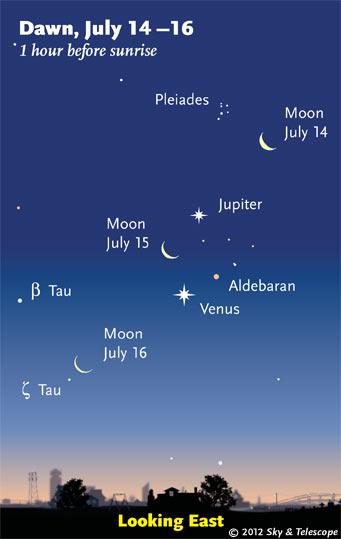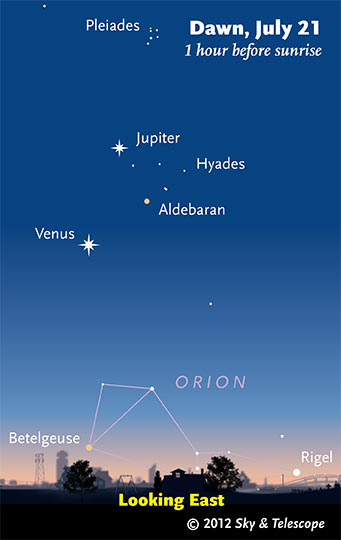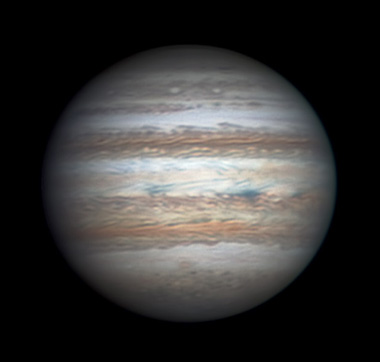
The waning Moon now adds itself to the multifarious dawn scene. (These scenes are drawn for the middle of North America. European observers: move each Moon symbol a quarter of the way toward the one for the previous date. For clarity, the Moon is shown three times actual size.)
Alan MacRobert
Friday, July 13
Saturday, July 14
The Moon actually occults Jupiter for most of Europe and parts of Asia; map and timetable. Jupiter disappears behind the Moon's sunlit limb.
Sunday, July 15
Monday, July 16
Tuesday, July 17
Wednesday, July 18
Thursday, July 19

Venus and Jupiter gradually move farther apart as they climb higher in the dawn. (The orientation of these scenes is exact for viewers at latitude 40° north.)
Sky & Telescope diagram
Friday, July 20
Saturday, July 21
Want to become a better amateur astronomer? Learn your way around the constellations. They're the key to locating everything fainter and deeper to hunt with binoculars or a telescope.
For an easy-to-use constellation guide covering the whole evening sky, use the big monthly map in the center of each issue of Sky & Telescope, the essential magazine of astronomy. Or download our free Getting Started in Astronomy booklet (which only has bimonthly maps).
Sky Atlas 2000.0 (the color Deluxe Edition is shown here) plots 81,312 stars to magnitude 8.5. That includes most of the stars that you can see in a good finderscope, and typically one or two stars that will fall within a 50× telescope's field of view wherever you point. About 2,700 deep-sky objects to hunt are plotted among the stars.
Alan MacRobert
Once you get a telescope, to put it to good use you'll need a detailed, large-scale sky atlas (set of charts). The standards are the little Pocket Sky Atlas, which shows stars to magnitude 7.6; the larger and deeper Sky Atlas 2000.0 (stars to magnitude 8.5); and the even larger Uranometria 2000.0 (stars to magnitude 9.75). And read how to use sky charts effectively.
You'll also want a good deep-sky guidebook, such as Sue French's Deep-Sky Wonders collection (which includes its own charts), Sky Atlas 2000.0 Companion by Strong and Sinnott, the bigger Night Sky Observer's Guide by Kepple and Sanner, or the classic if dated Burnham's Celestial Handbook.
Can a computerized telescope replace charts? I don't think so — not for beginners, anyway, and especially not on mounts and tripods that are less than top-quality mechanically (able to point with better than 0.2° repeatability). As Terence Dickinson and Alan Dyer say in their invaluable Backyard Astronomer's Guide, "A full appreciation of the universe cannot come without developing the skills to find things in the sky and understanding how the sky works. This knowledge comes only by spending time under the stars with star maps in hand."
This Week's Planet Roundup

Jupiter's North and South Equatorial Belts have swapped appearances since last year! South here is up. The South Equatorial Belt (above center)has turned narrow and dark, while the North Equatorial Belt has turned paler and very broad, the opposite of how they used to appear. Christopher Go in the Philippines took this superb image on July 11th with a 14-inch telescope in, he says, “perfect seeing.â€
Mercury is lost in the sunset.
Venus and Jupiter (magnitudes –4.7 and –2.1) shine dramatically in the east before and during dawn. They're stacked about 8° apart now, with Jupiter on top. Look for Aldebaran, much fainter, moving away from Venus to its upper right. Also in Venus's starry background are the Hyades, and above Jupiter are the Pleiades. See the scenes above.
The asteroids Ceres and Vesta, magnitudes 9.1 and 8.4, are there too! See article Predawn Treats for Early Risers for the naked-eye aspect, and to find the asteroids, Ceres and Vesta: July 2012 – April 2013.
Mars (magnitude +1.0, in Virgo) glows orange in the west-southwest at dusk. It's lower right of the Saturn-and-Spica pair, by about 16°. Mars is heading their way; it will pass right between them in mid-August. In a telescope Mars is gibbous and very tiny, only 6 arcseconds wide.
Saturn (magnitude +0.8, in Virgo) shines in the southwest as the stars come out. Below it by nearly 5° is Spica, nearly the same brightness. After dark they move lower to the west-southwest.
Uranus (magnitude 5.8, at the Pisces-Cetus border) and Neptune (magnitude 7.8, in Aquarius) are high in the southeast and south before the first light of dawn. Finder charts.
All descriptions that relate to your horizon — including the words up, down, right, and left — are written for the world's mid-northern latitudes. Descriptions that also depend on longitude (mainly Moon positions) are for North America. Eastern Daylight Time (EDT) equals Universal Time (also known as UT, UTC, or GMT) minus 4 hours.
Like This Week's Sky at a Glance? Watch our weekly SkyWeek TV short. It's also playing on PBS!
To be sure to get the current Sky at a Glance, bookmark this URL:
http://SkyandTelescope.com/observing/ataglance?1=1
If pictures fail to load, refresh the page. If they still fail to load, change the 1 at the end of the URL to any other character and try again.
 0
0
Comments
You must be logged in to post a comment.